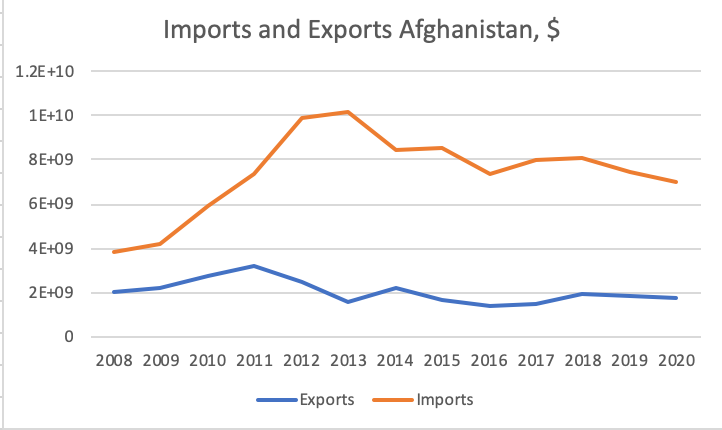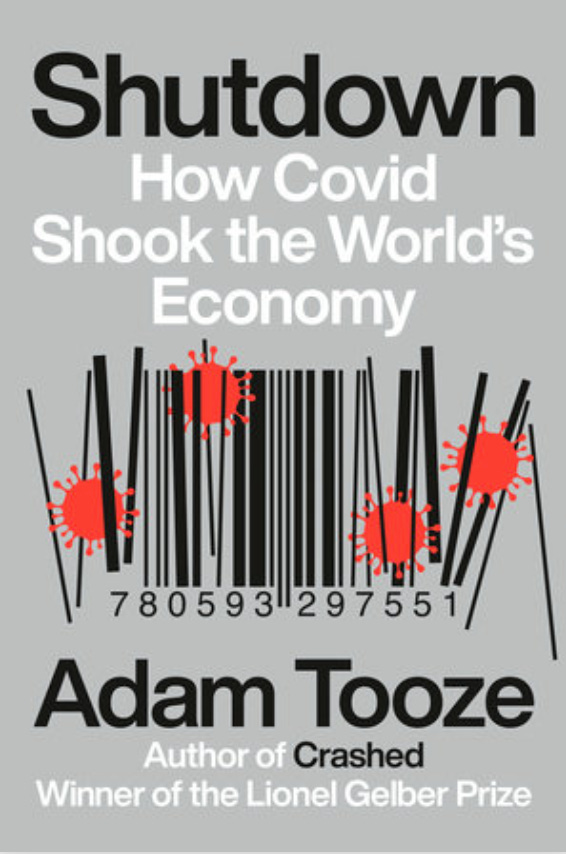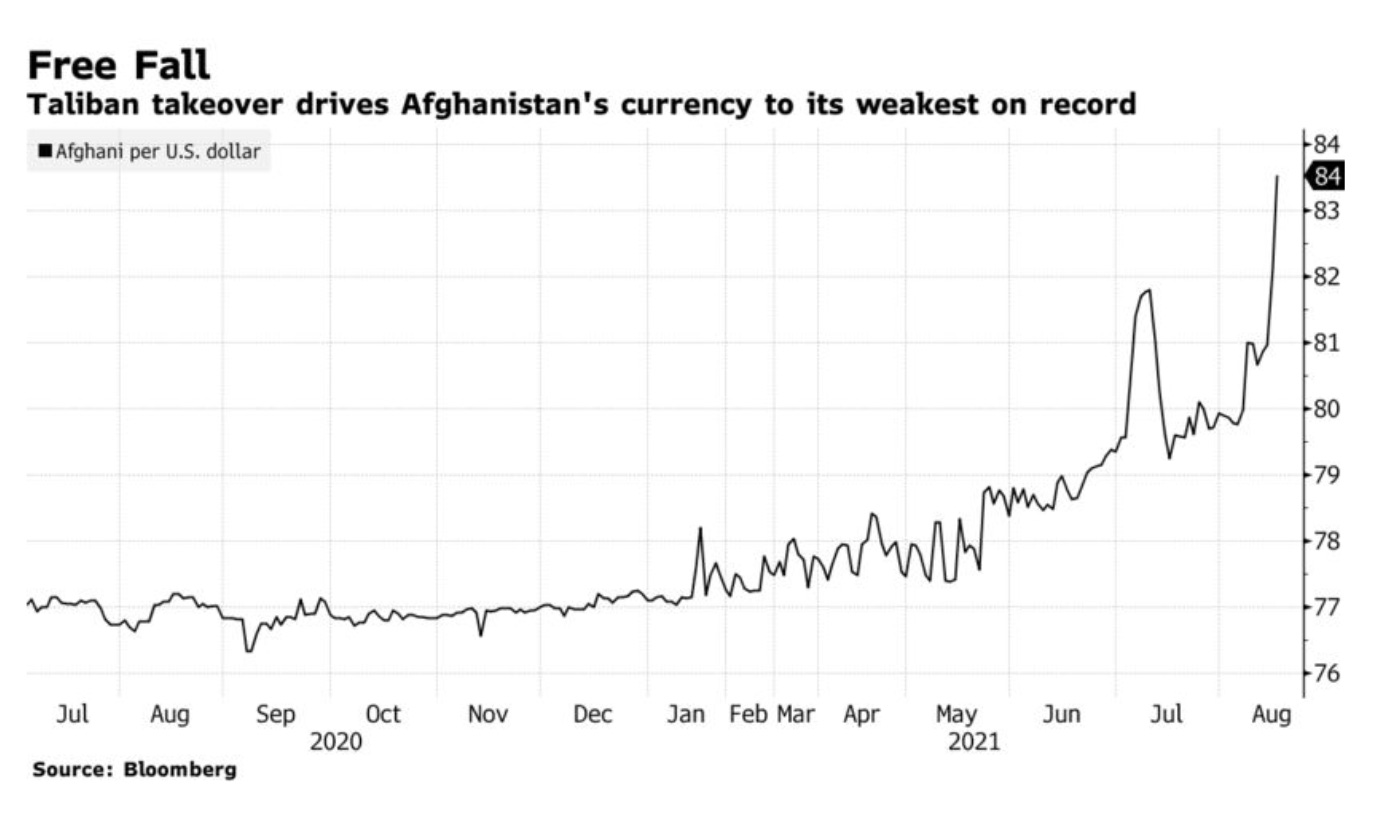The Taliban, a central banker and the problem of money.
As the Taliban establish their grip on power in Kabul, the question of finances rears its head. This matters so much, because the Afghan state has, in the recent past, been heavily dependent on foreign aid. The aid pays not just for government spending. Even more importantly it pays Afghanistan’s import bill.
Foreign exchange & the central bank reserves
Covering the import bill is more urgent, because with enough men with guns behind it, a state can tax its population and solve the problem of state finance. The Afghan Army is currently paid for largely by foreign donors. We do not doubt that the Taliban will find ways of maintaining its fighting force in being. It cannot use those same method to pay for foreign imports. And Afghanistan has an appetite for imports far in excess of what its exports pay for.

To pay for imports you need hard currency. The most obvious way an economy generates hard currency is through exports (NB: this is a short hand. Actually, businesses generate hard currency through foreign sales, which they may or may not wish to exchange for local currency, but lets not get into the complexities of this at this point). Alternatively you can borrow the foreign exchange, or, if you are a poor country, receive it in aid. Relative to its exports Afghanistan’s trade deficit has been huge. The gap has been closed by aid. Under Taliban rule, far less aid is likely to flow to Afghanistan.
It is this gap, which makes the question of who controls the reserves of the Afghan central bank and its holdings of foreign currency and gold so critical. Before we get to that a personal message about Chartbook.
An invitation
I love putting Chartbook together. But it takes a lot of work. I am delighted that it goes out free to many readers, but if you can afford to pitch in please consider doing so.
What do you get in return? Great karma and some goodies.
Top Links normally goes out in the full version only to paying subscribers. If you are enjoying this and would like to get the full emails regularly, sign up for one of the paying options.
There are three types of subscription:
- The annual subscription: $50 annually
- The standard monthly subscription: $5 monthly – which gives you a bit more flexibility.
- Founders club:$ 120 annually, or another amount at your discretion – for those who really love Chartbook Newsletter, or read it in a professional setting in which you regularly pay for subscriptions, please consider signing up for the Founders Club.
Other benefits will include a series of reading group sessions I will be organizing with subscribers following the release of Shutdown in the fall.

Back to business
The Afghan exchange reserves
As the Washington Post reports: “The Afghanistan central bank held $9.4 billion in reserve assets as of April, according to the International Monetary Fund. That amounts to roughly one-third of the country’s annual economic output. The vast majority of those reserves are not currently held in Afghanistan, one of the people familiar with the matter said. Among those, billions of dollars are kept in the United States, although the precise amount is unclear.”
An urgent conversation about the whereabouts of the $9.4 billion unfolded on twitter in recent days.
Afghanistan's central bank, da Afghanistan Bank, holds 703,005 ounces of gold, all deposited at the Federal Reserve Bank of New York. That's worth US$1.25 billion. It's a safe guess that with the Taliban taking over this gold will be frozen.
— John Paul Koning (@jp_koning) August 17, 2021
Source: https://t.co/wtF6QOlRtq pic.twitter.com/xxqImhtCeJ

Afghan’s former central bank boss, Ajmal Ahmady, whose escape from Kabul we followed by way of Twitter earlier this week, was interviewed by phone by the FT and he confirmed that the reserves were held outside the country. A
This thread is to clarify the location of DAB (Central Bank of Afghanistan) international reserves
— Ajmal Ahmady (@aahmady) August 18, 2021
I am writing this because I have been told Taliban are asking DAB staff about location of assets
If this is true – it is clear they urgently need to add an economist on their team
As Ahmady concluded his summary:
“Therefore, my base case would be the following: – Treasury freezes assets – Taliban have to implement capital controls and limit dollar access – Currency will depreciate – Inflation will rise as currency pass through is very high – This will hurt the poor as food prices increase.”
If you find Chartbook valuable, why not share with a friend:
Depreciation
According to CNN, the Afghani has been trading at a deep discount to the dollar, falling to as low as 100 to the dollar on Saturday before settling around 86.
At the end of 2020, as this Bloomberg graphic shows, it was trading around 77 to the dollar. This is clearly a steep depreciation, but not yet a collapse.

Cutting off the dollars
“Mr. Ahmady”, of the Afghan central bank told the WSJ, “that bank officials began reducing the amount of cash, including U.S. dollars, held at bank branches in provincial centers earlier this month amid concerns over the Taliban’s advance. By the time the first major provincial capital fell to the Taliban nearly two weeks ago, nearly all U.S. dollars had been repatriated, he said. “During this entire period, no dollars fell into the hands of Taliban before Kabul fell,” Mr. Ahmady said. “All of it was secured.”
Now the US administration is working to prevent the new power holders in Kabul benefiting from a $450 million issuance of Special Drawing Rights, which the IMF is preparing in the coming days.
Planeloads of cash:
This from Brookings:
“Afghanistan’s previous government, we have to say it was never flush, but it did regularly receive planeloads of cash from the US government and it was used to pay salaries of officials and keep the wheels of government just turning. There were bulk shipments of dollars expected as late as last Sunday, but it never arrived.”
Ajmal Ahmady – a rejected central bank governor
The tweets by Afghan central banker Ahmady have made him into something of a celebrity witness to the collapse of the Ghani regime. What is less often noted is Ahmady’s own position. He is reputed to be engaged to ex-President Ghani’s daughter. His appointment by Ghani went hand in hand with what appeared to be a politically motivated purge of the central bank and in December 2020 Ahmady’s nomination was rejected by a large majority of the Afghan parliament.
This report from Central Banking is a fascinating source, also on the last time that the Taliban were in charge at the Afghan central bank.
Obviously, Afghanistan is rife with corruption and its politics is bitterly factional. It is a society in which accusations of corruption are easily instrumentalized. Ahmady came into the central bank wielding massive allegations of corruption against senior staff that took many by surprise. Central Banking is a serious source and they are are unable to arbitrate the issue to their satisfaction. In any case, if you want to have some idea of whose commentary you are following on twitter, the piece in Central Banking is an extraordinary mine of information.
Remittances and Western Union
Apart from official reserves and exports, another important source of foreign exchange are remittances from the Afghan diaspora. Remittances amount to nearly 4% of Afghanistan’s gross domestic product. But how does the money reach Afghanistan?
Afghanistan has a famous network of informal money changers. But as far as western banking agencies are concerned, Afghanistan is now a no go area. Western Union ceased services to Afghanistan earlier in the week.
China & India
One possible source of support could be China. It will be interesting to see how long it takes before finance begins to be an issue in relations between Kabul and Beijing.
One American reading is that China may be principally concerned with the $282 billion that it has invested in the One Belt One Road projects that span Afghanistan and are anchored in Pakistan.
In neighboring India there is already fevered speculation about possible investment deals
Taliban tolls
Foreign currency is likely to be a serious issue for the Taliban regime, but as far as domestic taxation is concerned, the Taliban have a considerable track record.
This Economist article gives a vivid description of their system of transport tolls.
Taliban economics
This remarkable report by David Mansfield and Graeme Smith published by the ODI think tank gives a deep insight into the way in which the Taliban have recently been taxing the local economy in one Iranian border region. As you can see, its revenue flow is dominated not by illegal drugs but by trade in fuel and border transit.

David Mansfield is a great source to follow on the Afghanistan situation.
As the FT reports, the Taliban are attempting to present themselves as a force for narcotic suppression: “Speaking this week at a press conference, Taliban spokesperson Zabihullah Mujahid insisted the movement wanted to eschew drugs and “revive our economy”. “Afghanistan will from now on be a narcotics-free country but it needs international assistance. The international community should help us so that we can have alternative crops,” he said on Tuesday.”
Afghanistan 1979
If you are looking for a glimpse of Afghanistan before it was wrenched into the violent dynamic of the Cold War in 1979, this is a remarkable documentary:
For the remarkable story of a Afghan film-making and the women archivists who are trying to preserve it this story in the Indian magazine The Wire is fascinating and moving.
It has never been easy to be an Afghan filmmaker.
— The Wire (@thewire_in) August 17, 2021
The Afghan archivists had managed to save 7,000 movies totalling up to 32,000 hours of 16mm film and 8,000 hours of 35mm film. | @Plebeian42 https://t.co/Ki3TFL3Y9c

